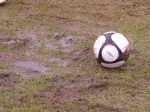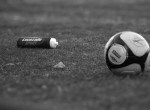Marseille
Leave a commentOLYMPIQUE DE MARSEILLE – STADE VELODROME – CAPACITY: 60,031 ALL SEATER
 About the Stade Vélodrome
About the Stade Vélodrome
The Stade Vélodrome is the biggest club stadium in France and certainly one of the most atmospheric even though it only has one side with a roof. The stadium was originally built as a cycling track – hence its name and the facilities to add football to the list of events it hosts began in 1937. It wasn’t until the late 1990’s that the cycle track was actually removed. In 1938 the stadium hosted a number of matches in the World Cup Finals, including the semi-final between Italy and Brazil.
Since then the stadium has been developed on a number of occasions, raising the capacity over time to the current 60,000 limit. The most unique feature of the stadium is the huge Tribune Ganay that holds over 20,000 supporters alone. There are current plans to redevelop both ends of the stadium, and to add a roof to the remaining three sides to take the capacity to 80,000. Such a move seems interesting as technically the stadium has never sold out – the record attendance being just under 59,000 for a UEFA Cup semi-final versus Newcastle United in 2004.
The views from any part of the stadium are very good – even in the upper parts of the Ganay. The four stands are actually names after local celebrities – such as Chevalier Roze who stopped the spread of the Bubonic Plague in the 18th century. The hardcore Marseille fans can be found at either end of the stadium in the Virage’s.
Who plays there?
Whilst the stadium is world-known for the home of OM – Olympique Marseille, the stadium has gained a reputation as one of the finest stadiums in the world for hosting Rugby. In fact the French national team are frequently visitors to the stadium, and actually went over 4 years unbeaten at the stadium until 2004. The ground will also host a number of matches in the forthcoming Rugby World Cup finals.
However, the stadium is famed throughout the world as the home of OM – Olympique Marseille. Despite its recent problems, the club are undoubtedly the biggest in France, and some would argue the most successful. They were originally formed in 1899, although success didn’t really arrive in the south of France until late 1980’s and the arrival of the millions of francs from new owner Bernard Tapie.
The club won their first honours in the 1920’s, winning successive French cup titles in 1926 and 1927. In 1937 the club won their first title in the new professional era of French football. The following few years saw another couple of French cups, as well as a second championship in 1948. In the 1970’s the club took the opportunity to become the most successful French team when they won the double in 1972. However, their success was short-lived as the Platini inspired Saint Etienne dominated domestic and European football in the mid 1970’s. In 1986 Bernard Tapie arrived as the new owner of the club, thanks to the money of Adidas and the political power of then mayor Gaston Deferre.
He immediately started funding a revolution in French football with big name players such as Jean-Pierre Papin, Chris Waddle, Eric Cantona and Enzo Francescoli arriving in the next few years. Success did not take long to arrive as the club won the domestic double again in 1989, followed by Championship titles in 1990, 1991 and 1992. In 1991 the club reached the final of the Champions League, losing to Red Star Belgrade on penalties in Bari. Two years later they reached the final again in Munich where they recorded their finest moment in their history when they beat AC Milan 1-0.
In 1994 the football world was shocked by revelations of match fixing involving Tapie the club were relegated to the second division and had their Champions League title striped. Their exile lasted all of two seasons as they returned to the top division as champions in 1995 – thanks to the goals of Tony Cascarino. The investment in the team was once again forthcoming from Adidas – this time from Robert Louis-Dreyfus.
Since then they have failed to match the ambition and investment by Lyon domestically, although in Europe they have managed to reach two UEFA Cup Finals in 1999 and 2004 where they lost to Parma and Valencia respectively. In 2007 they had the chance to win some silverware for the first time in fifteen years when they reached the French cup final. However, they lost on penalties to the underdogs Sochaux. They can be consoled by a second place finish in the league, and a return to the Champions League group stages in 2007/08, although in the new season campaign they could not catch Bordeaux and Lyon at the top so had to make do with a 3rd place finish this time around.
How to get there
The impressive Stade Vélodrome is located in the south east part of the city, around about 4km from the centre. The easiest way to reach the stadium is by Metro, on Line 2 to Ste Marguerite/Dromel which is five stops and 8 minutes journey time from St Charles SNCF station. Exit the station via the Rond Point du Prado exit and you will see the stadium straight ahead. Alternatively you can catch bus 83 from the city centre.
For a better overview of football in France, go to Footiemap.com to view their excellent and comprehensive graphical overview of French football.
Getting a ticket
Whilst Marseille are the best supported team in France, the average attendance in previous seasons at the stadium has only rarely broken the 50,000 barrier, meaning that there tends to be on average around 10,000 seats available on the day of the game.
Tickets generally go on sale 10 days before the match from the ticket office at the ground, and from the club shop at OM Café Vieux Port, the official Tourist Office at 4 La Canebière and any Carrefour and FNAC store throughout France. They can also be bought online from the official site at http://www.om.net.
Ticket prices range from €30 in the Tribune Ganay which is the huge open stand, to €50 in the Balcon which offers some protection from the elements. Tickets for either Virage (area behind the goal) are only on sale to club members.
Getting around
Marseille is not the easiest city to navigate. Anyone who has tried to locate a particular address by driving through the narrow streets will testify the frustrations of everyday Marseille. The city does have a two line metro system that intersects at Gare Saint-Charles. The nearest station to the action in the old town is Vieux Port. Buses compliment the metro for journeys to the outskirts.
Nearest Airport – Marseille Provence (MRS)
Telephone: +33 442 14 1414
Website: http://www.marseille.provence.fr
Marseille Provence airport is located 27km north west of the city centre and is now the busiest airport in the country outside Paris, handling over 6million passengers a year.
It has two terminals, including one that is specifically for budget airlines. To reach the city centre, catch one of the buses that run every 20 minutes to Gare St Charles. The bus costs €8.50 each way. The following airlines currently fly to Marseille on a daily basis. British Airways from London Gatwick, BMIBaby from Birmingham, Easyjet from London Gatwick and Bristol and finally Ryanair from Bournemouth, Glasgow-Prestwick and London Stansted.



 .
. .
. .
. .
. .
. .
. .
. .
. .
. .
.